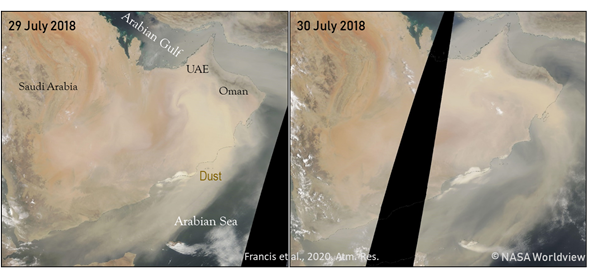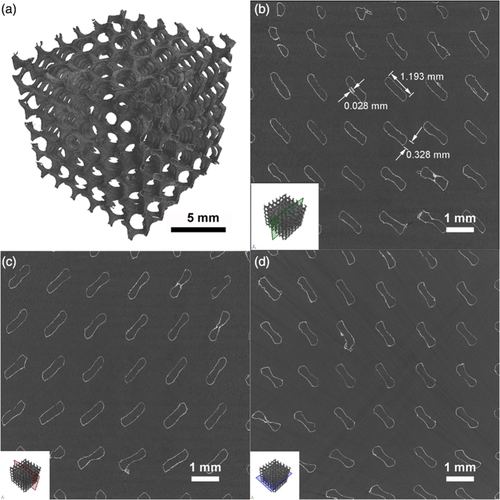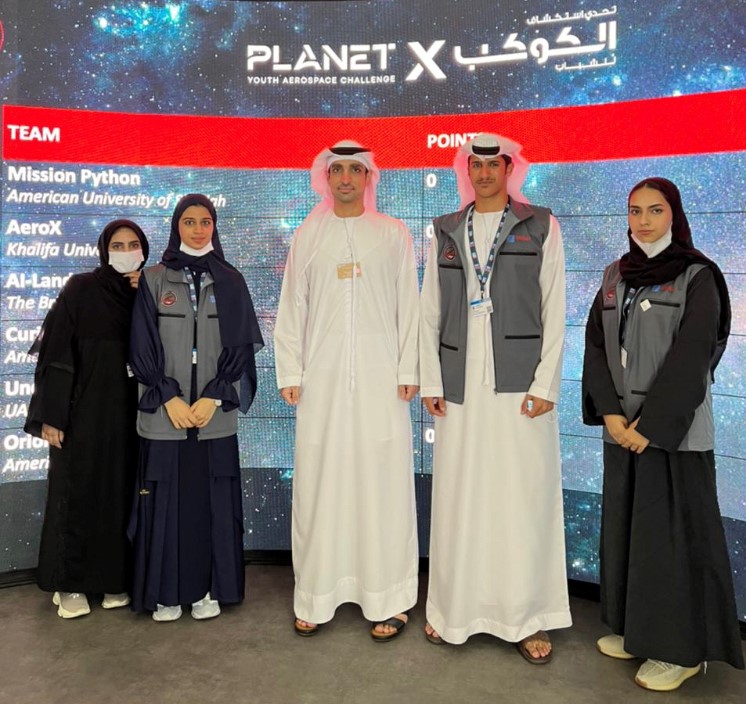
Despite how frequent dust storms are in the Middle East, little is known about how and why they are so much more common in the summer months. A team from Khalifa University set out to better understand this phenomenon by examining the intense dust activity that occurred in July 2018.
The Arabian Peninsula is one of the world’s major sources of dust year round, contributing substantially to the total amount of dust in the air in the Northern Hemisphere. Frequent dust storms occur here, between 15 to 20 per year, impacting all aspects of life for its human population, as well as affecting marine ecosystems and the climate.
Despite this, little is known about how and why dust storms are much more common in the summer months. A team from Khalifa University set out to better understand this phenomenon by examining the intense dust activity that occurred in July 2018.
Dr. Diana Francis, Senior Research Scientist, Dr. Narendra Nelli, Postdoctoral Fellow, and Dr. Marouane Temimi, Associate
Professor of Civil Infrastructure and Environmental Engineering, all from Khalifa University, published their findings in the journal of Atmospheric Research along with Dr. Jean-Pierre Chaboureau, University of Toulouse, France, Dr. Juan Cuesta, Université Paris-Est Creteil, France, Noor Alshamsi, UAE National Center for Meteorology, Dr. Olivier Pauluis, New York University, and Dr. Lulin Xue, US National Center for Atmospheric Research. The team investigated the dust storms of July 2018 to identify the underlying atmospheric dynamics and assess how much impact the radiative effects of dust had on cloud and rain development.
“Despite originating from relatively few areas around the world, atmospheric dust is an important component of the Earth’s climate system,” explained Dr. Francis. “Atmospheric dust particles can serve as cloud condensation nuclei and ice nucleating particles, thereby altering cloud development and properties and associated precipitation.”
The amount of dust in the air also influences radiative effects as dust particles can scatter and absorb shortwave radiation, and absorb and re-emit longwave radiation. This has repercussions for atmospheric thermodynamics as the local temperature, winds and rainfall are affected.
“The dust in the air interacts with radiation from the sun and increases the mass of water in the atmosphere, causing a greenhouse effect and further increasing the ground temperature and humidity,” explained Dr. Francis. “This then has implications on the development of weather features such as sea breezes.”
Though the dust does reduce the amount of solar energy reaching the surface by absorbing and scattering the radiation, this absorption can contribute to localized heating by directly warming the dust-filled atmospheric layer and emitting longwave radiation towards the surface of the Earth. This, however, depends on where the dust layer is located, such as whether it is situated over water, vegetated areas or desert regions.
“Given the sporadic nature of dust storms, this complex balance between their effects on radiation and the resulting impacts on climate has been difficult to assess,” explained Dr. Francis.
“Because of this, dust storms can’t be included in future climate projections with much accuracy, with current global climate models underestimating the warming effect of dust by underestimating the actual amount of dust in the atmosphere.”
An essential part of the dust cycle is the transportation of dust around the world. For this, the dust storm needs the atmospheric processes that determine all aspects of the storm—from its intensity to its duration. For the Arabian Peninsula, the Shamal winds play a critical role. These northerly semi-permanent winds are thought to be the main meteorological driver for dust emissions year round but Dr. Francis is interested in why dust emissions over the southern parts of the Arabian Peninsula peak in the summer.
“This peak indicates the existence of a still-unknown but important mechanism for dust emissions,” explained Dr. Francis.
“Cyclogenesis, the formation of cyclone, has proven to be a major dust emission mechanism over other arid regions, capable of generating dramatic dust storms. However, little attention has been given to dust activity associated with cyclogenesis over the Arabian Peninsula”
In July 2018, a cyclone formed over southwestern UAE and generated intense dust emissions over the UAE and northwestern Oman due to strong cyclonic winds.
“A clear footprint of the cloud was visible in the radiation measurements at the surface, with the warming effect by up to 10°C induced by the dust especially at night,” explained Dr. Francis.
“On the second day of cyclogenesis, clouds started to develop in the warm sector of the cyclone,” explained Dr. Francis. “Localized rain was observed in the southwestern UAE, and as the cyclone intensified, more water vapor was drawn from the Arabian Gulf and the Arabian Sea, which caused further rain to develop. Daytime ground temperatures were two degrees higher compared to prior days, while at night, temperatures were ten degrees higher than the normal temperature before and after the dust storm. This was due to sustained emissions of longwave radiation during the entire lifetime of the dust storm.”
The researchers found that the dust over a major dust source region induces a significant net warming effect at the surface and in the atmosphere during the night, modifying the atmosphere at lower levels. Their results highlight the important role dust plays in the climate system of the Arabian Peninsula, proving that air quality and weather forecast systems need to account for the impacts of dust storms to achieve improved accuracy.
“Dust also needs to be considered when predicting, designing and conducting cloud-seeding operations in the UAE because of the impact on the circulation, which in turn impacts the development of clouds and their lifetime,” added Dr. Francis. “Dust is a quasi-permanent natural part of the atmosphere over the Arabian Peninsula, and its impact on the climate and environment of this region is more significant than anyone previously thought.”
Jade Sterling
Science Writer
13 August 2020





